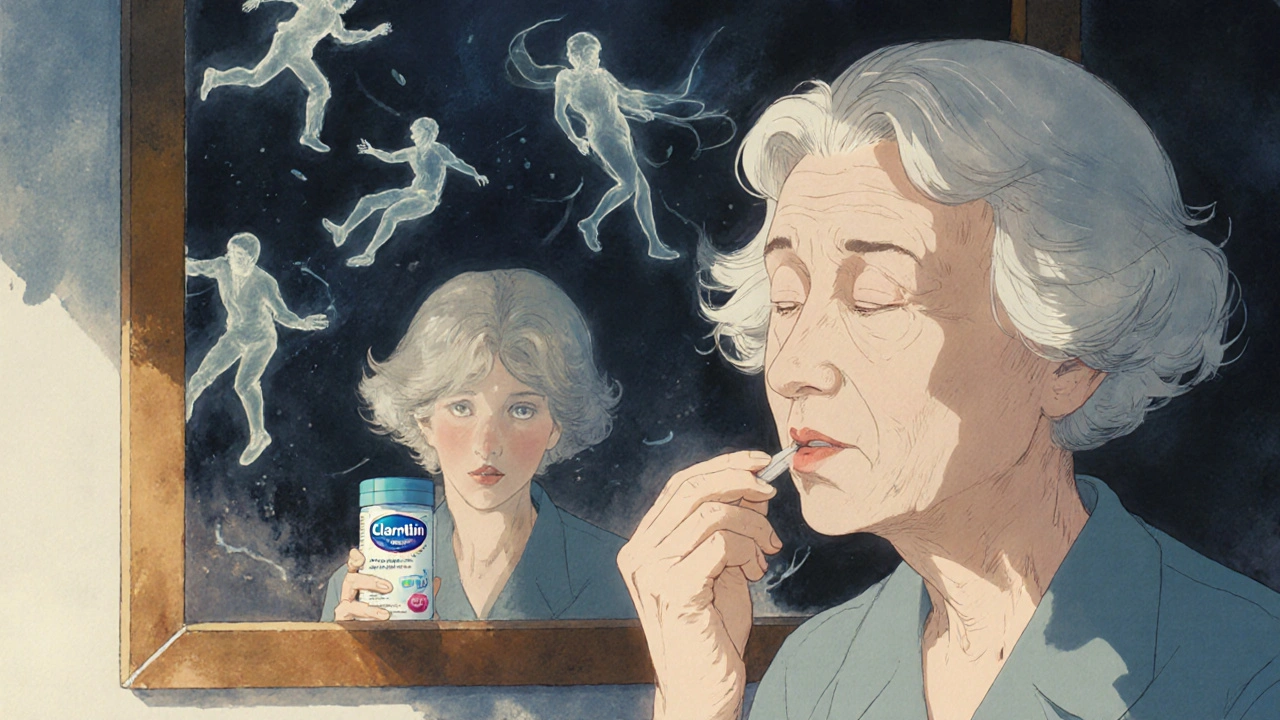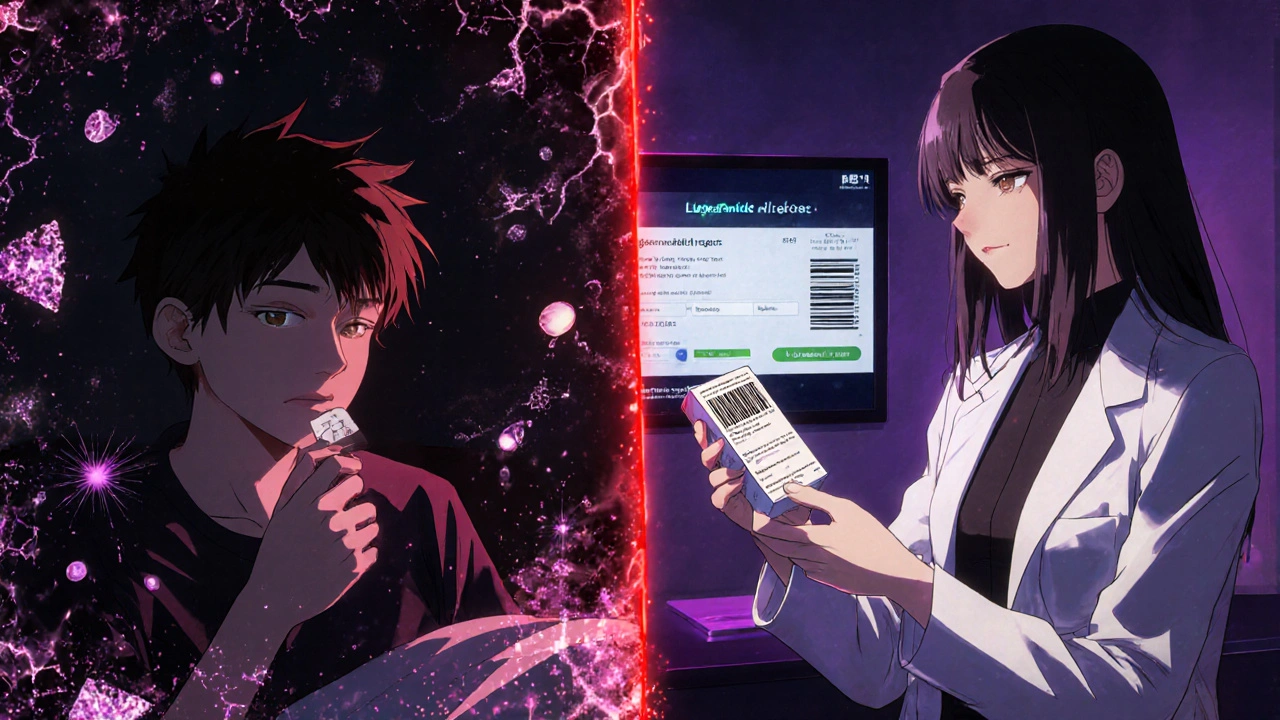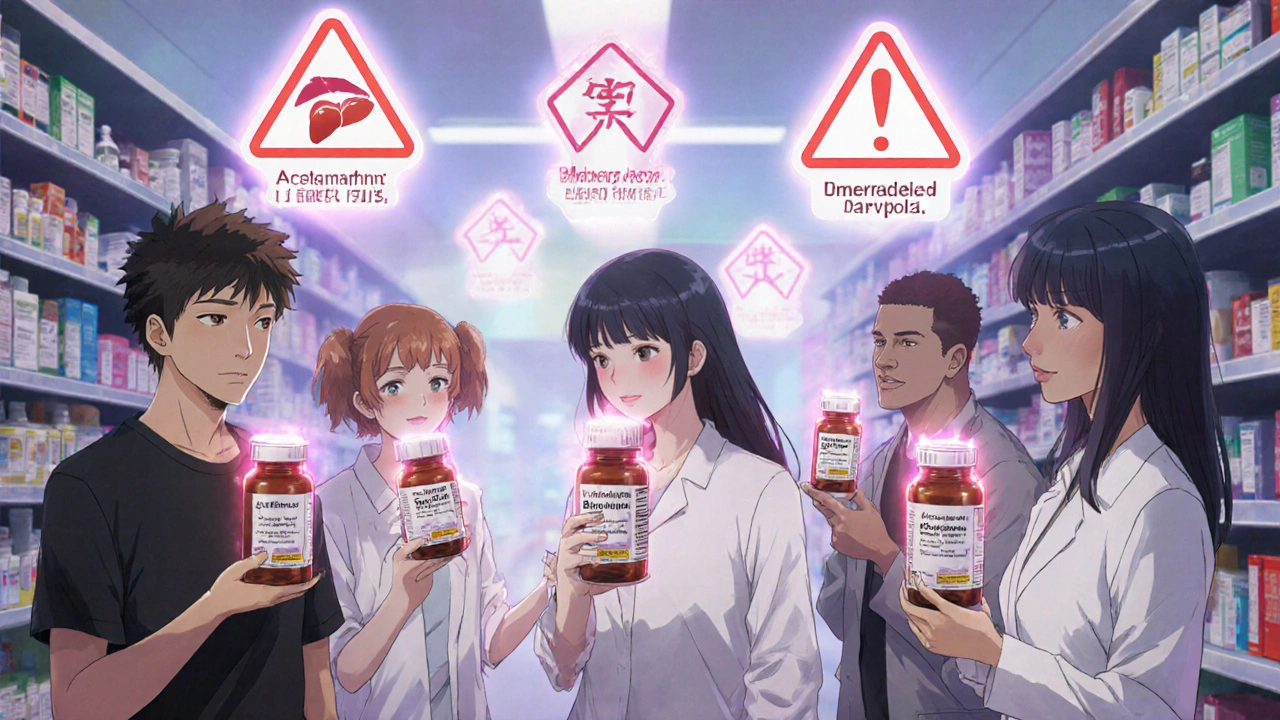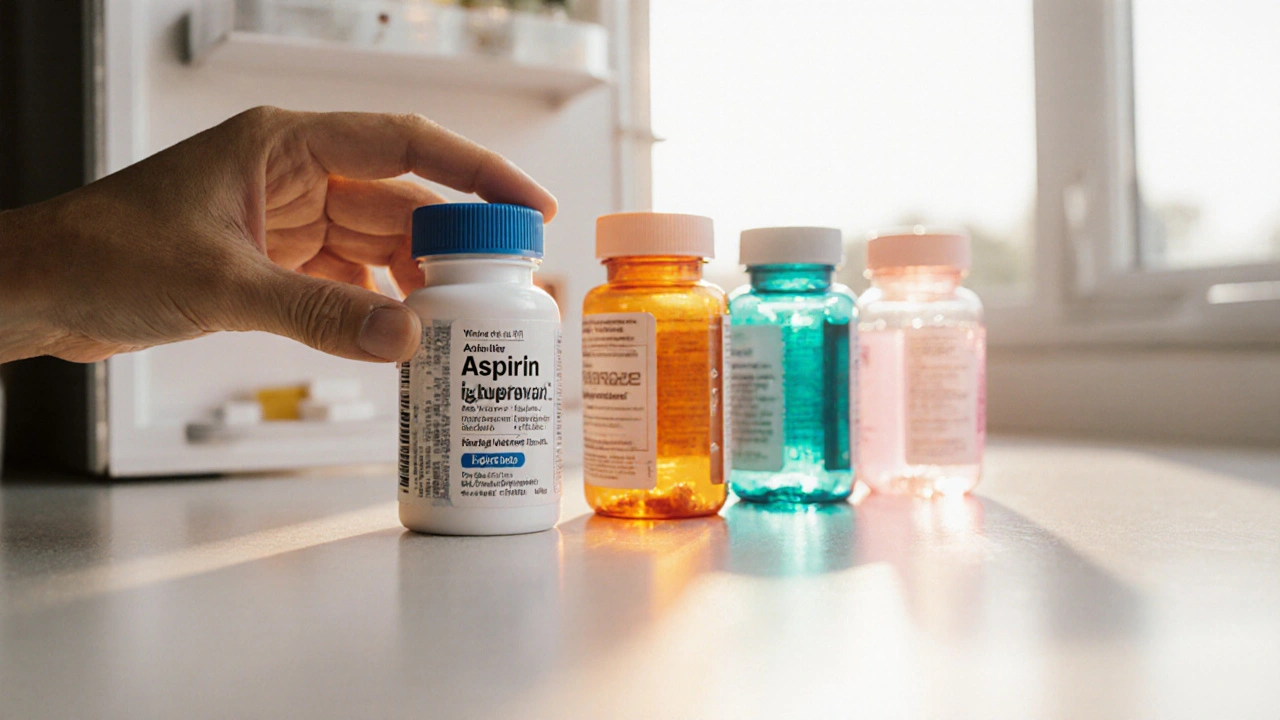Every year, millions of people reach for an OTC medication without thinking twice. A headache? Grab some acetaminophen. Stuffy nose? Reach for pseudoephedrine. Heartburn? Pop a pill of omeprazole. It’s easy to assume these drugs are harmless because you don’t need a prescription. But that’s exactly where things go wrong.
What OTC Medications Really Are
Over-the-counter (OTC) medications are drugs approved by health regulators like the FDA and TGA for direct consumer use. They’re meant for short-term relief of minor, self-diagnosable conditions - not long-term treatment of chronic illnesses. In the U.S. alone, there are over 100,000 OTC products with more than 800 active ingredients. In Australia, they’re split into three tiers: general sale (supermarkets), pharmacy-only (must be sold by a pharmacist), and pharmacist-only (require consultation). The key difference from prescription drugs? OTCs are considered safe enough for people to use without a doctor’s supervision - if used correctly.
Pain Relievers: Acetaminophen vs. NSAIDs
When it comes to pain or fever, most people choose between acetaminophen (Tylenol) and NSAIDs like ibuprofen (Advil) or naproxen (Aleve). But they work very differently.
Acetaminophen is the go-to for fever and mild to moderate pain. It’s safer for kids, pregnant women, and people with stomach issues or bleeding disorders. But it’s hard on the liver. Taking more than 4,000mg in 24 hours - even just a few extra tablets - can cause severe liver damage. The FDA estimates 15,000 to 18,000 hospitalizations each year from acetaminophen overdoses. Many people don’t realize it’s in cold medicines, sleep aids, and combo pills. Always check the label.
NSAIDs like ibuprofen and naproxen reduce inflammation, which makes them better for muscle aches, sprains, or arthritis. But they irritate the stomach lining and can cause ulcers or internal bleeding. People with kidney disease, high blood pressure, or heart conditions should avoid them. And never take NSAIDs after 20 weeks of pregnancy - they can harm the baby’s kidneys.
Here’s the simple rule: Use acetaminophen if you’re unsure. Use NSAIDs only if you need the anti-inflammatory effect - and never for more than 10 days without checking with a pharmacist.
Cold, Flu, and Allergy Medicines
OTC cold and allergy meds are a minefield of overlapping ingredients. Many products combine multiple drugs - pain relievers, decongestants, antihistamines - in one pill. That’s a recipe for accidental overdose.
Dextromethorphan (in cough syrups like Delsym) suppresses coughs. It’s safe at recommended doses, but teens sometimes abuse it for its hallucinogenic effects. Over 1.2 million ER visits in the U.S. each year involve OTC drug misuse, and dextromethorphan is a top offender.
Pseudoephedrine (Sudafed) shrinks swollen nasal passages. It’s effective but kept behind the counter because it’s used to make illegal meth. You need to show ID and sign a logbook to buy it.
Antihistamines come in two types: old and new. First-gen options like diphenhydramine (Benadryl) work fast but cause drowsiness, dry mouth, and confusion - especially dangerous for people over 65. A 2021 JAMA study found seniors on diphenhydramine had a 30% higher risk of falling. Second-gen antihistamines like loratadine (Claritin) and fexofenadine (Allegra) work just as well with almost no sedation. They’re the smart choice for daily allergy relief.

Heartburn and Digestive Aids
Heartburn is common, and OTC options are everywhere. But not all are created equal.
Antacids like Tums (calcium carbonate) give fast, short-term relief. They’re fine for occasional use. But if you’re taking them daily for weeks, you might be masking something serious - like GERD or an ulcer.
H2 blockers like famotidine (Pepcid AC) reduce acid production. They work slower than antacids but last longer. Safe for most people, even during pregnancy.
Proton pump inhibitors (PPIs) like omeprazole (Prilosec OTC) are the strongest. They’re great for frequent heartburn, but not for daily, long-term use. A 2023 JAMA study linked long-term PPI use to a 20-50% higher risk of chronic kidney disease. Also, they can interfere with nutrient absorption and increase infection risk. Use them for no more than 14 days in a row - and only once every four months unless your doctor says otherwise.
When OTC Medications Are Dangerous
Many people think, “It’s just a pill,” and ignore the warnings. But OTC drugs can be deadly when misused.
- Acetaminophen + alcohol = high risk of liver failure. Even one drink a day while taking it can be risky.
- NSAIDs + blood thinners = dangerous bleeding. Don’t combine them with aspirin, warfarin, or even fish oil without checking.
- Diphenhydramine for sleep = not safe for older adults. It causes confusion, urinary retention, and dizziness - leading to falls.
- Loperamide (Imodium) for diarrhea is fine short-term, but taking more than directed can cause heart rhythm problems. Some people abuse it to get high - a deadly mistake.
And don’t forget: many OTC products contain sugar, alcohol, or dyes. People with diabetes, liver disease, or allergies need to read labels carefully. Some antidiarrheals and cough syrups have hidden sugar - enough to spike blood glucose.
Who Should Be Extra Careful
Not everyone can safely use the same OTC meds.
- Pregnant women: Only acetaminophen is generally safe for pain. Avoid NSAIDs after 20 weeks. Skip decongestants like pseudoephedrine in the first trimester.
- Seniors over 65: Avoid first-gen antihistamines. Use lower doses of acetaminophen (max 3,000mg/day). Be cautious with NSAIDs - kidney function declines with age.
- Children under 4: Never give cough or cold medicines. They’re not safe and don’t work. Use saline drops and a humidifier instead.
- People with liver or kidney disease: Acetaminophen and NSAIDs can be toxic. Talk to a pharmacist before using anything.
- People on multiple medications: OTC drugs can interact with prescriptions. A simple antacid can block absorption of antibiotics or thyroid meds.

How to Use OTC Medications Safely
Here’s how to avoid mistakes:
- Read the Drug Facts label. It’s required by law. Look for active ingredients, dosage, warnings, and expiration date.
- Don’t double-dose. Check if your cold medicine already has acetaminophen before taking a separate pain reliever.
- Use the lowest effective dose. You don’t need to take the maximum unless symptoms demand it.
- Don’t use for more than 7-10 days. If symptoms persist, see a doctor. OTC meds aren’t meant to treat underlying conditions.
- Store properly. Keep meds in a cool, dry place. Don’t leave them in the bathroom or car. Heat and moisture ruin them.
- Check expiration dates. Expired meds lose potency. Some, like epinephrine auto-injectors, can become dangerous.
- Ask your pharmacist. They’re trained to spot interactions. Nearly 93% of Americans live within 5 miles of a pharmacy. Use them.
What’s Changing in OTC Medications
The OTC landscape is shifting. In 2023, the FDA updated labeling rules to make Drug Facts clearer. Now, you’ll see exact doses, clear warnings, and plain language.
Some new products are emerging: higher-dose loperamide for faster diarrhea relief, and fluticasone furoate (Veramyst) - the first intranasal steroid available without age restrictions for allergies.
Pharmacists are taking on more responsibility. In Australia and parts of the U.S., pharmacists can now prescribe certain OTC meds for minor conditions - like urinary tract infections or eczema - after a quick consultation. This trend will grow. By 2027, up to 20% more OTC meds may be pharmacist-prescribed.
Digital tools are also helping. CVS Health’s AI-powered OTC Advisor app scans your meds and tells you if something might interact. Apps like these could reduce misuse - if used responsibly.
Final Thought: OTC Doesn’t Mean Risk-Free
OTC medications are powerful tools. They’ve saved countless people from unnecessary doctor visits. But they’re still drugs. They have side effects. They interact. They can harm if misused.
Don’t treat them like candy. Don’t assume they’re safe because they’re on a shelf. Always ask: Is this the right medicine for my symptom? Am I taking the right dose? Could this hurt me?
If you’re unsure - talk to a pharmacist. They’re there to help. And if symptoms don’t improve in a few days, see a doctor. Self-care is smart. Self-medication without knowledge? That’s dangerous.
Can I take acetaminophen and ibuprofen together?
Yes, you can take them together if needed, but only under specific conditions. Acetaminophen and ibuprofen work differently, so combining them can give better pain relief than either alone. But don’t exceed the maximum daily dose for either - 4,000mg for acetaminophen and 1,200mg for ibuprofen. Space doses at least 4 hours apart. Avoid this combo if you have liver or kidney problems, or if you’re drinking alcohol regularly. Always check labels to avoid accidental overdose from combination products.
Are OTC cold medicines safe for kids?
No, OTC cough and cold medicines are not safe for children under 4. The FDA banned their use in this age group after 115 deaths were linked to overdoses between 1969 and 2006. For older kids, use only products labeled for their age, and follow dosing by weight, not age. Liquid forms are preferred. For congestion, use saline drops and a bulb syringe. For fever or pain, use acetaminophen or ibuprofen - but only if needed and at the correct dose.
Can I use OTC pain relievers every day for arthritis?
No. OTC pain relievers are meant for short-term relief, not daily management of chronic conditions like arthritis. Taking NSAIDs every day for months increases your risk of stomach ulcers, kidney damage, and heart problems. Acetaminophen daily can lead to liver damage. If you need daily pain relief, see a doctor. There are better long-term options, including physical therapy, prescription meds, or injections. OTC drugs are not a substitute for proper diagnosis and treatment.
Why are some OTC drugs kept behind the counter?
Some OTC drugs, like pseudoephedrine, are kept behind the counter because they can be used to make illegal drugs - like methamphetamine. Even though they’re legally available, their sale is restricted to prevent misuse. You’ll need to show ID and sign a logbook. Other drugs, like higher-dose loperamide or certain antihistamines, are kept behind the counter because they carry higher risks of abuse or overdose. Pharmacists can then offer guidance on safe use.
What should I do if I think I’ve taken too much OTC medicine?
If you suspect an overdose - especially with acetaminophen, ibuprofen, or dextromethorphan - call poison control immediately or go to the ER. Do not wait for symptoms. Acetaminophen overdose can cause liver failure without immediate signs. In Australia, call 13 11 26. In the U.S., call 1-800-222-1222. Bring the medicine bottle with you. Time matters. Even if you feel fine, internal damage may already be happening.
Can OTC meds interact with my prescription drugs?
Absolutely. Antacids can block absorption of antibiotics like tetracycline or thyroid meds like levothyroxine. NSAIDs can make blood pressure meds less effective and increase bleeding risk with warfarin. Even common supplements like St. John’s Wort can interfere. Always tell your pharmacist what prescriptions you’re taking before buying OTC meds. They’ll check for interactions you might not know about.
Is it safe to take OTC meds while pregnant?
Only acetaminophen is generally considered safe for pain and fever during pregnancy. Avoid NSAIDs after 20 weeks - they can affect fetal kidney development. For allergies, loratadine or cetirizine are preferred over diphenhydramine. For heartburn, antacids like Tums are fine, but avoid PPIs unless prescribed. Always check with your doctor or pharmacist before taking anything, even if it’s labeled "OTC." Your baby’s health depends on it.
How do I know if an OTC medicine is expired?
Check the expiration date on the packaging - it’s usually printed on the bottle, box, or blister pack. Most OTC meds are good for 2-3 years from manufacture, but heat, light, and moisture can reduce their shelf life. If the medicine smells odd, looks discolored, or has changed texture (like tablets crumbling or liquids turning cloudy), throw it out. Don’t take expired meds - they may not work, and some can break down into harmful substances.
Are herbal OTC remedies safe?
Not necessarily. Herbal products like echinacea, ginger, or melatonin aren’t regulated like pharmaceuticals. They can vary in strength, contain contaminants, or interact with your meds. Melatonin can worsen depression and affect blood pressure. Echinacea may trigger allergies. Always treat herbal OTC products with the same caution as pills. Talk to a pharmacist before using them - especially if you’re pregnant, elderly, or on other medications.
What’s the best way to store OTC medications at home?
Store them in a cool, dry place - like a bedroom drawer or cabinet - away from sunlight and moisture. Don’t keep them in the bathroom, where steam and heat can ruin them. Keep them out of reach of children and pets. Use childproof caps. Don’t transfer pills to unmarked containers - you might forget what’s inside. Check your medicine cabinet every 6 months and throw out anything expired or unused. A cluttered, outdated cabinet is a safety hazard.
Next time you reach for an OTC pill, pause. Read the label. Ask yourself: Am I treating the symptom - or just masking a problem that needs real care?


